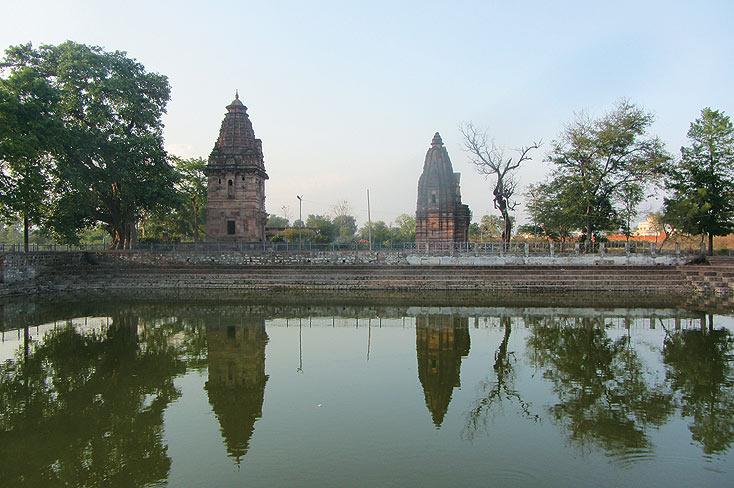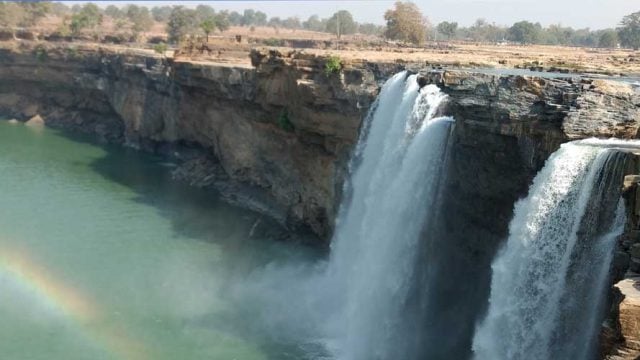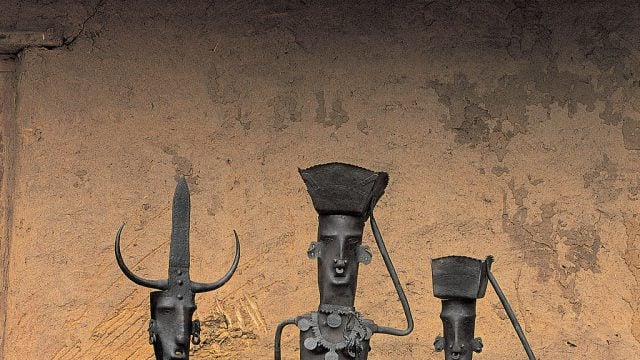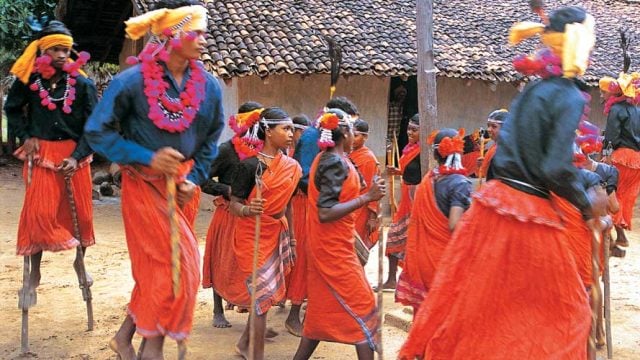A circular stone structure sits atop a vast plateau of weather-beaten rock; above it, a
This is the 64Yogini Temple of Ranipur-Jharial and we have travelled all day to reach it: by air from Delhi to Raipur, the capital of Chhattisgarh, and on by road deep into forested western Odisha. For my three companions, it is a pilgrimage of sorts: each has a personal relationship with the yoginis, that group of tantric spirits or goddesses who flew about the skies and took on animal or human form to land on earth, described as ‘magnificent, magical and absolutely lethal’ by contemporary tantric Jan Fries.
Stella Dupuis — hands-down the chicest of our group, today wearing an outfit the colour of alphonso mangoes with toenails to match — has written books about them after chancing upon a similar temple, Hirapur near Bhubaneswar, in 2005 and “falling in love.” “The yoginis were expecting me,” she has written, “My whole life seemed to have been a prologue to that encounter.” She has visited Ranipur-Jharial so many times she can’t quite remember. “I love coming here,” she says, “It is not the kind of place you go to once and cross off your list, you keep on visiting. It is magical.”
Seema Kohli, the acclaimed artist-seeker of all that is Shakti, has recently incorporated the yoginis of the Bheraghat Temple into her performance work in a piece entitled “Parikrama”. And Janet Chawla, whose years of research and activism have earned her an encyclopaedic knowledge of indigenous ‘womanity’, is visiting her fourth yogini temple.
In her book The Yogini Temples of India: In the Pursuit of a Mystery, Stella includes 17 sites associated with the yoginis, but only three of these are temples with an almost full complement of yogini sculptures still in situ. In other places, the sculptures have vanished (in some cases to museums or collectors in the West: one has recently been returned from France to much fanfare in the capital) or the temples have vanished or part vanished.
The yogini temples at Ranipur-Jharial, Hirapur and Bheraghat are typical in design: circular and open to the air with yogini sculptures placed around their interior walls, in an inversion of the standard Indian temple form with its emphasis on exterior decoration and a deep interior sanctum in which to seek darshan of the deity.
From the expanse of rock and sky, we enter the intimacy of the shrine. In niches around the circumference stand the thousand-year-old yoginis, with legs bent, as if about to dance through the green ASI railings put in place to protect them. They are rather magnificent: about half human size, thick-thighed and buxom, with beautiful faces and luscious lips, or with the head of a leopard, horse or snake. A patina of age lies over them, and in places, the weather has completely knocked away features and attributes; they seem to recede mysteriously into the stone whence they came.
The Kularnava Tantra calls the yogini cult “the secret cult which is the most secret among the secret doctrines.” But we do know a little about it, mainly thanks to extensive research done by Vidya Dehejia. From her book Yogini Cult and Temples: A Tantric Tradition, we learn that yogini worship emerged around CE 700 and flourished between the ninth and twelfth centuries, reaching across India, often with royal patronage; that the yoginis “were regarded as patron deities by those who followed the heterodox path known as the Kaula Marga”; that their correct worship could grant siddhis or magical powers such as — according to another important text, the Kaulajnananirnaya — the ability to see from a great distance, to possess remarkable speed, to be loved by one and all, to enter another’s body, and to have control over decay and death; and in pursuit of these occult powers, tantric rites were performed.
Hours elapse as we explore the yoginis’ physical and spiritual terrain. Close by is a large rock cut with the Matrikas (who are often, but not at Ranipur-Jharial, part of the yogini group). There’s an active Shiva temple, and small structures resembling personal meditation huts dot the plateau. But it is to the circle of yoginis that we return. They inspire in my companions dancing, mantras, mudras and meditation — in fact, Stella wants to stay right here meditating under the full moon all night. I now understand scholar David Gordon White’s description of these temples as ‘landing fields’ and ‘launching pads’: it would not be that surprising to see a buxom boar-faced being dance down from the sky, especially towards evening.
As the sun lowers, Stella presents a deck of tarot cards she has designed with her sister—the ‘Oracle of the Yoginis.’ We sit for readings at the feet of Shiva Bhairava, who stands as he should at the centre of the yogini circle. Stella explains how in her tarot the beautiful, benign yoginis are protective, the demonic yoginis help us to overcome our fears, and the animal-headed or theriomorphic direct us to reconnect with our instincts. We are entranced.
In the early morning, the yoginis are awash in a glorious golden light, a fresh wind blows from the south and morning sounds — of birdsong and children’s voices and the slap of cloth upon rock — drift to us across the plateau. But we dare not linger long; an Odisha-wide hartal has been called by the ruling BJD party in protest at the central government.
Trouble is waiting in the last one-bullock town before the border with Chhattisgarh. Here, when our driver stops and opens his window to speak to the group manning the barricade, a hand darts in to snatch the keys from our ignition. Thank the yoginis our driver’s hand is quicker; and thank the lone policeman who somehow succeeds in placating the agitated men. We drive on without daring to stop until we are well inside Chhattisgarh, which contrary to its reputation, now represents a haven of safety.
Our pilgrimage in Chhattisgarh is to leafy, sleepy Talagaon by the Maniyari River, not far from Bilaspur in the north of the state. Tala is home to the rich red sandstone remains of the 5th or 6th century Jethani and Deorani temples and to a unique sculpture known as ‘Rudrashiva.’ Actually, my companions explain, we don’t know who he is: he could be Shiva in his Pashupatinath form; he may not be Shiva at all. There is no other sculpture like him in existence and no textual source either.
Seema persuades the caretaker to open the bars behind which he is kept padlocked, and we are able to get a really close view. More than two metres high and at least a metre wide, he is the most remarkable composite of human and animal features, a distant cousin of a Giuseppe Arcimboldo painting. Take his face: his nose and eyebrows are a lizard, his eyes are frogs, his chin a crab, his moustache two fish, his ears are peacocks and his hair a coiled snake. His shoulders are like alligators’ jaws (but they have non-alligator ears), his knees are tigers, his erect phallus is a snake, as are his fingers, his belly and his breasts are big round human faces with wide flat lips and noses.
Seema enters a world where only she and Rudrashiva exist. Purposefully she walks, from tap to sculpture, steel pail swinging, emanating mantras, throwing buckets and buckets of water, 12 in all, to ensure that every part of his body is wet. We watch mesmerized, dodging stray sheets of water, as her “reverence” unfolds. Stella, meanwhile, is engaged in her own ritual documentation of every part of the sculpture’s extraordinary form with her video camera. She refers to him fondly thereafter as “my Bhairava”.
We visit other sites in Chhattisgarh. The state is dotted with the fine archaeological remains of towns and temples, once-thriving cosmopolitan centres that are now sleepy backwaters. In Sirpur, we find an exquisite Buddha and an archaeological dig closed because too many grazing cows had fallen into it; in an effort to bear the heat, we shower — fully clothed — under a pipe in the village centre. In Malhar, we chance upon a shivling with no ling; “it’s a yoni inside a yoni inside a yoni,” my companions cry in excitement. We seem to meet the goddess or some aspect of her wherever we go.
But the most resonant place for us all was the strange circular temple on the spare plateau of rock where the yoginis of Ranipur-Jharial were first worshipped more than a millennium ago.
The information
Getting there
There are daily flights to Raipur from Delhi, Mumbai, Kolkata and other major cities.
Getting around
We hired an Innova from CG Travels ([email protected] or Dinesh on 9009189187 in Raipur). In four days we covered morethan 1,000km and got lost only once.
Where to stay
In Kantabanji, Odisha, we stayed at Alishan Palace (from Rs 400; alishanpalace.com). There is a government guesthouse at Ranipur-Jharial, but it looks little used.
In Raipur, Chhattisgarh, Hotel Babylon International was comfortable (from Rs 5,500; hotelbabylon.com). In Bilaspur, Chhattisgarh, the newly constructed Hotel Central Point International opposite the Chhattisgarh High Court was comfortable (from Rs 2,200; h[email protected], 9669507000, 9669508000).
What to see & do
Odisha
Visit the Ranipur-Jharial Yogini Temple, walk the labyrinthine paths laid out on the plateau, visit the fine brick Indralath temple and the Someshwar temple by the lake and seek out the panel of Matrikas carved into a rock. There could have been as many as 200 temples here at one time, but it’s hard to imagine today as it feels so deserted, though the atmosphere is still charged with the sacred.
Chhattisgarh
The Rudrashiva sculpture in Talagaon is like nothing else you will ever experience. Don’t miss it. We also visited Sirpur, Malhar and Ratanpur.
Top tips
Stella’s book on the yoginis and that of Vidya Dehejia’s make for helpful companions. The Eicher Goodearth Guide to Chhattisgarh is excellent.
Odisha
Ranipur Jharial
Ranipur Jharial Yogini Temple
Leave a Reply
You must be logged in to post a comment.





